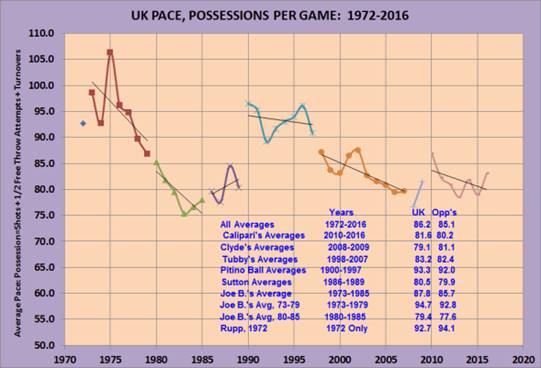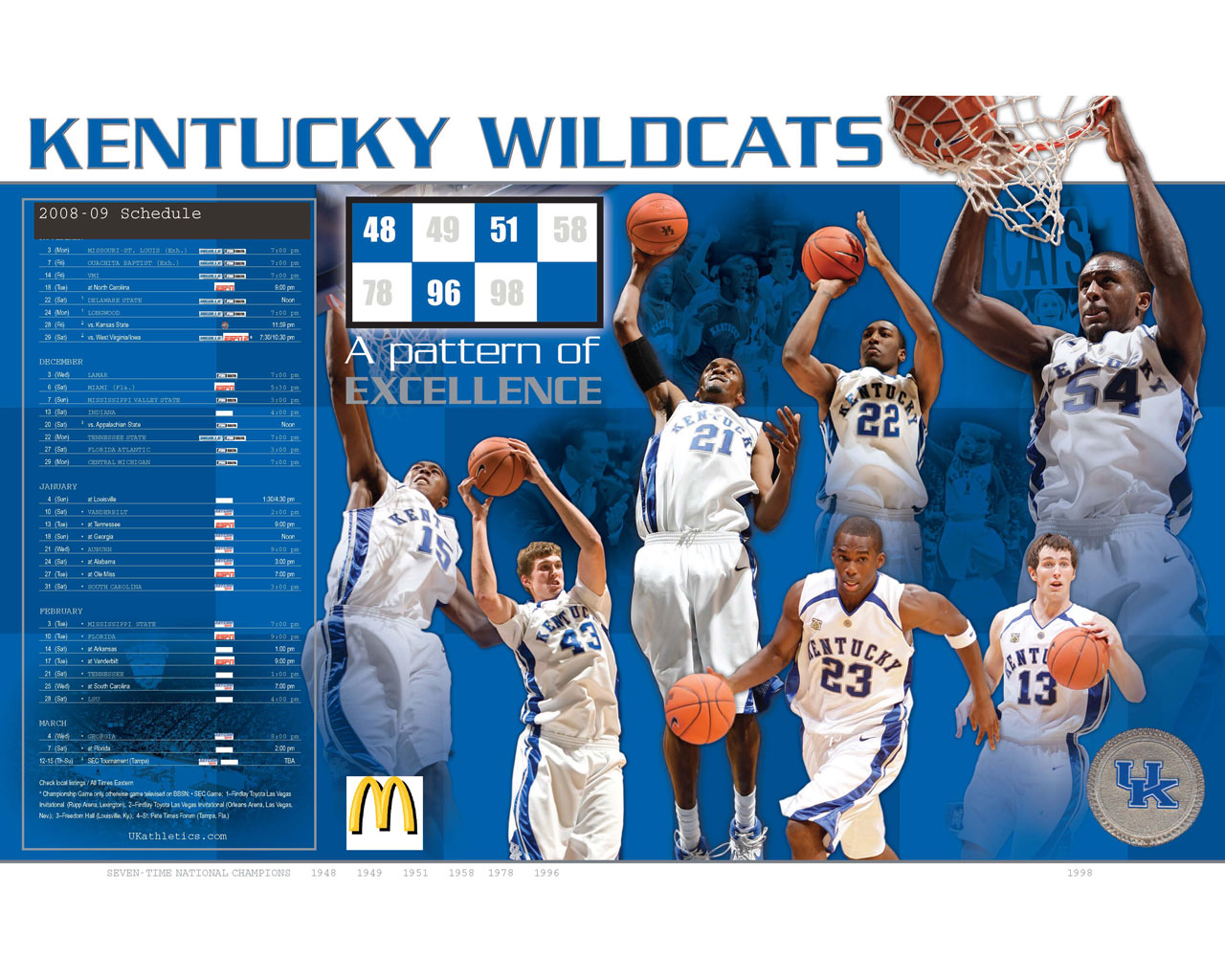BIG BLUE FANS FOR

BASKETBALL
2016-17 Season Analytical Writings
01A
UK BASKETBALL PACE: 1972-2016
People often talk about the pace (tempo is also used) and speed of a basketball game, and folks often use these terms interchangeably. However, they are different on subtle levels. It always amazes me when a coach or a fan speaks about how fast his team has played, or will play. Usually, these references address the speed of moving up or down the court between possession changes rather than the pace of play, measured by the number of possessions that occur during a 40-minute basketball game.
However, regardless of the terminology, the college basketball game has slowed down dramatically, not just for UK, but also for all teams. Pace is the number of possessions in an average game. The only debatable aspect of pace is whether an offensive rebound starts a new possession or continues the current possession. Pomeroy treats on offensive rebound as a continuation of a possession. When I started, I treated an offensive rebound as a new possession for a very practical reason. In the 1990's, many college basketball published statistics did not include offensive rebounding data. Therefore, the only calculation I could make was: Possession = Field Goal Attempts + 1/2 Free Throw Attempts + Turnovers. To compute a Pomeroy possession, subtract the number of Offensive Rebounds.

For these reasons, my data, prior to 2000, is all based on my original definition of a possession, and since 2000, I have the data in both formats. I cannot convert the pace definition for 1972 to 1999 to the Pomeroy definition I have adopted since 2000, but I can convert the 2000+ pace back to the original basis. The graph shows the pace, using this consistent definition, since 1972, segmented by UK coach.
Few people who were blessed to watch Coach Rupp's teams doubt that his teams played the game at an elevated pace. His last year, 1972 is represented on this graph, with an average pace of 92.7 possessions per game (ppg). Joe Hall's teams from 1973 through 1979 had a peak pace in 1975 at 106.3 ppg. Thereafter, Coach Hall's teams played a progressively slower and slower pace until he retired following the 1985 season. Do you recall the fan criticism about Coach Hall in these latter years that Joe B. is holding his teams back, he will not allow the guards to shoot, etc. In some measure, at the time Coach Hall announced his retirement, there was hope within the Big Blue Nation that UK basketball might return to the run and gun style perfected by Rupp and continued by Coach Hall through the 1978 championship season. Coach Sutton stopped the pace slide during his four seasons, and some might see the trend toward an increasing pace through his tenure, before the wheels came off.
Then Pitino appeared on the scene. He immediately treated the fans to a pace in excess of 90 ppg where it remained through his tenure. When he left, Tubby Smith's teams immediately returned to the slower pace. Tubby's teams continued to play at progressively slower pace until eventually slipping into the upper 70s during his last two seasons. Billy Gillispie's teams did not change from this trend.
When coach Calipari arrived, he knew that a significant segment of the Big Blue Nation hoped to see a return to a pace at least in the upper 80s if not in the 90s. His first UK team teased the fans with an immediate jump to the upper 80s. I recall Coach Calipari speaking often about wanting to play faster. However, after 2010, his teams returned to a pace in the low 80s and upper 70s, the same range that Tubby established at the end of his tenure. Despite Calipari's continuing assertions about playing fast (speed), the pace of play did not change.
I have written about this issue for about 20 years, starting with Tubby's arrival after he immediately put the brakes on and slowed down UK's game in 1998. He continued to slow it down, and I continued to point out the impact he was having on the pace of play until the day he left.
There are 2400 seconds in a basketball game. At a pace of 80 possessions per game, the average possession required 15.0 seconds. That seems incredibly fast given a 30 or 35 second, or even a 24-second shot clock. However, reflect on Coach Rupp's teams, Coach Hall's 1970's teams, and Pitino's teams of the early to mid-1990s and you will find these teams averaged between 90 and 100 possessions per game. The 1996 team averaged 96 ppg, which is 12.5 seconds per possession. The 1975 UK team averaged 106 ppg, which is 11.3 seconds per possession.
I do not know about the rest of you, but I love to watch the game when it is played at these truly elevated paces. For all the good Coach Calipari has done with the UK program, he has not played the game at a faster pace at UK than his immediate predecessors have. Nevertheless, he continues to talk as if he has.
One last point, I believe defense and powerful offensive rebounding are what elevate the pace. Recall how the 1996 (and all Pitino UK teams) played defense. I recall many games in 1996 in which that team created multiple possessions in the course of just a few seconds by forcing turnover after turnover, denying the opponent an opportunity to even cross mid-court. That is how the average time per possession is forced down. A passive defense will never be an instrument for a fast-paced game. With respect to offensive rebounding, each one produces a new possession. The 2010 Calipari team was dominant on the offensive glass, which is why it ended with a pace in the upper 80s.
Submitted by Richard Cheeks


Submitted by Richard Cheeks
![]()
To 02 Exhibition Game 01-Clarion
Go Back
To Pre-Season Overview
Copyright 2016
SugarHill Communications of Kentucky
All Rights Reserved